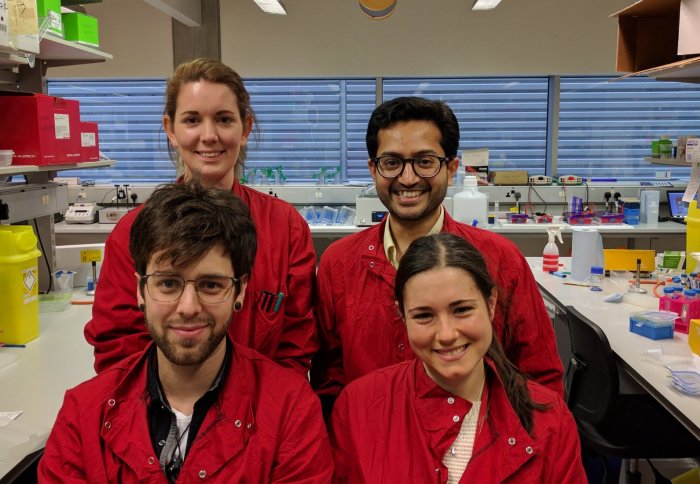
Back row: Pippa Goddard, Avinash Shenoy Front row: Matt Eldridge, Julia Sanchez-Garrido

During infection, the initial onset of inflammation helps launch protective anti-microbial responses, but if left unchecked, causes damage to tissue.
During infection, the initial onset of inflammation helps launch protective anti-microbial responses. However, inflammation is a ‘double-edge sword’ and, if left unchecked, causes damage to tissue. In a study recently published in Cell Reports, Dr Shenoy’s group found a role for the molecule UBE2L3 in regulating inflammation. Their work has helped uncover secrets of how our immune system strikes the balance between good and bad inflammation.
Inflammation is often initiated and maintained by a molecule called IL-1β, which is secreted by special immune cells called macrophages. Importantly, IL-1β is stored as an inactive non-inflammatory precursor molecule called pro-IL-1β. During infection, enzymes convert the precursor into its inflammatory form which helps clear infection. Scientists have known how enzymes covert the precursor into IL-1β however, little is understood about the precursor molecule itself. Dr Shenoy’s study shows that cells are able to eliminate precursor IL-1β molecules which can reduce unwanted inflammation.
Using sophisticated molecular proteomic analyses, performed at Imperial College, Dr Shenoy and colleagues found that infected cells which are poised to release inflammatory IL-1β have low levels of another molecule called UBE2L3. This intriguing finding raised a number of questions which kept the group, which includes 3 PhD students who are co-authors, busy for better part of the last 3 years.
Two questions were particularly important: why infected cells lose UBE2L3 molecules and what would happen if they didn’t? To answer them, the group re-engineered cells so that they do not lose UBE2L3 molecules. Interestingly, in these so-called high-UBE2L3 cells the levels of IL-1β precursor molecules are markedly reduced, and as a result they released very little inflammatory IL-1β. It was beginning to make sense – infected cells lose UBE2L3 and release higher IL-1β to protect against harmful bacteria, such as the diarrhoeal pathogens Salmonella and Listeria which the group used for their study.
Detailed molecular studies showed that UBE2L3 removes precursor IL-1β molecules by sending it to the cell’s trash handling system called the proteasome. Thus, when IL-1β should not be secreted i.e. in the absence of infection, UBE2L3 destroys IL-1β precursor and prevents inadvertent inflammation. The Shenoy group soon realised that UBE2L3 modulates the levels of IL-1β precursor molecules and fine-tunes inflammation.
There are many important implications of this study. IL-1β-driven inflammation is linked to many modern-day non-communicable diseases such as diabetes, arthritis and atherosclerosis. Indeed, therapeutics that target secreted IL-1β are used in the clinic. However, this discovery of a molecule that eliminates the precursor even before it is released provides an additional route for drug-discovery. As a molecule that can lower inflammation, UBE2L3 could be exploited for new therapeutics against inflammatory diseases. The Shenoy group has already initiated collaborative studies on these lines. Furthermore, natural alterations in the DNA sequence of the UBE2L3 gene in humans are linked to inflammatory conditions such as systemic lupus erythematosus, celiac disease and Crohn’s disease. Thus, their study provides additional clues as to how UBE2L3 molecules might cause inflammation, and lays the foundation for more ambitious future work.
The study was funded by the Wellcome Trust and the Royal Society grants to Dr. Shenoy. The lead author, Matthew Eldridge, is supported by an MRC-funded, 3-year PhD studentship..
Article text (excluding photos or graphics) available under an Attribution-NonCommercial-ShareAlike Creative Commons license.
Photos and graphics subject to third party copyright used with permission or © Imperial College London.
Reporter
Kylie Glasgow
Department of Infectious Disease



